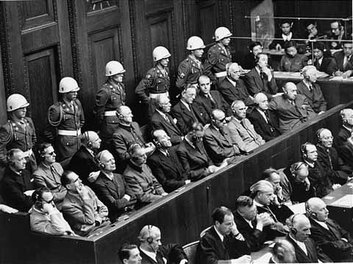The Nuremberg Trials were two sets of trials that the Allied countries during World War II had which tried the top Nazi political and business leaders. These trials were held at the Nuremberg Palace of Justice in Nuremberg, Germany. The International Military Tribunal tried twenty-one of the highest ranking Nazi officials. The most famous trial began on November 20, 1945. This trial tried the most important Nazi leaders. The second set of trials, run by the U.S. Nuremberg Military Tribunals tried the lesser war criminals over the course of twelve trials.
Throughout the course of World War II, the Allies met to discuss the treatment of Nazi leaders once the war had ended. Once the war was coming to an end, President Roosevelt asked the War Department to come up with a plan for how to bring these criminals to justice. Many approaches were discussed such as shooting prominent Nazi leaders and banish others, and even having a fair trial for them in court. In April 1945, the Supreme Court Justice Robert Jackson was appointed as head prosecutor for the United States at a war-crimes trial that would be held in Europe once the war ended.
The International Military Tribunal was headed by four of the main Allied countries: the United States, Great Britain, Russia, and France. These countries decided that a judge and one alternate judge would be appointed from each prosecuting country. Many Nazi leaders were brought to justice through these trials, but some still escaped trial and punishment by killing themselves prior to the trials. On April 30, 1945, Hitler shot himself right before the Soviet Troops came to take him away. Other prominent leaders also took their own lives through different forms. There were four counts that these leaders were being tried for: conspiracy to wage aggressive war, waging an aggressive war, war crimes, and crimes against humanity. During the trials, lawyers for each defendant presented their evidence and tried to shine some light on what had taken place.
On October 1, 1946, the defendants entered the court room to hear their sentences. 18 defendants were convicted and three were found not guilty. Eleven leaders were sentenced to death by hanging. Three were acquitted and the rest were given prison sentences anywhere from ten years to life. Ten men were hanged on November 1946, one of them committed suicide shortly before he was scheduled to be executed. This would not fix the horrors that had taken place in Nazi Germany during World War II, but it did help to bring some justice to the world.
Throughout the course of World War II, the Allies met to discuss the treatment of Nazi leaders once the war had ended. Once the war was coming to an end, President Roosevelt asked the War Department to come up with a plan for how to bring these criminals to justice. Many approaches were discussed such as shooting prominent Nazi leaders and banish others, and even having a fair trial for them in court. In April 1945, the Supreme Court Justice Robert Jackson was appointed as head prosecutor for the United States at a war-crimes trial that would be held in Europe once the war ended.
The International Military Tribunal was headed by four of the main Allied countries: the United States, Great Britain, Russia, and France. These countries decided that a judge and one alternate judge would be appointed from each prosecuting country. Many Nazi leaders were brought to justice through these trials, but some still escaped trial and punishment by killing themselves prior to the trials. On April 30, 1945, Hitler shot himself right before the Soviet Troops came to take him away. Other prominent leaders also took their own lives through different forms. There were four counts that these leaders were being tried for: conspiracy to wage aggressive war, waging an aggressive war, war crimes, and crimes against humanity. During the trials, lawyers for each defendant presented their evidence and tried to shine some light on what had taken place.
On October 1, 1946, the defendants entered the court room to hear their sentences. 18 defendants were convicted and three were found not guilty. Eleven leaders were sentenced to death by hanging. Three were acquitted and the rest were given prison sentences anywhere from ten years to life. Ten men were hanged on November 1946, one of them committed suicide shortly before he was scheduled to be executed. This would not fix the horrors that had taken place in Nazi Germany during World War II, but it did help to bring some justice to the world.

